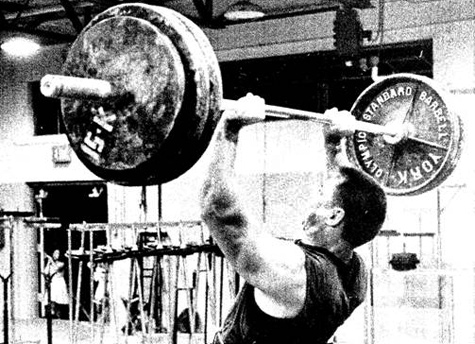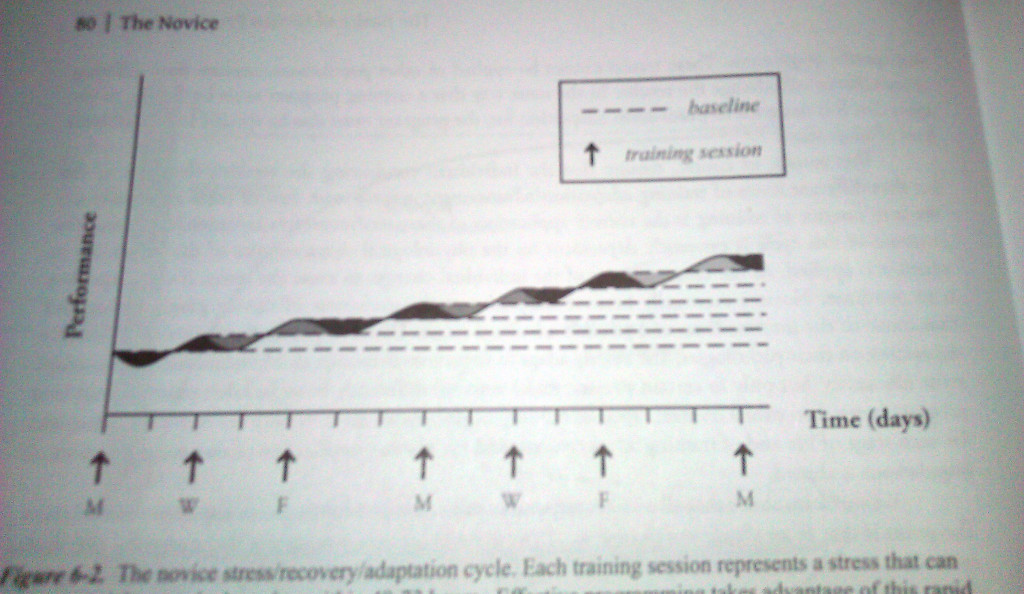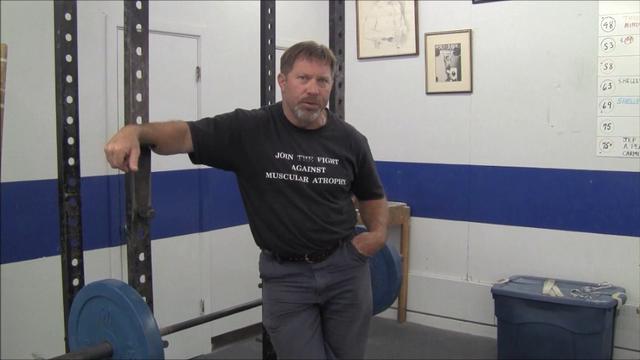In the previous articles of the Powerlifting Programs series, making particular use of ProgrammingToWin’s concepts of the novice, intermediate, and advanced trainee, we laid down the necessary foundations to begin analyzing many of the popular programs that are currently floating around the internet. If you haven’t read the first three parts of this series, now would be a good time to do so.
The reality is that, at any given time, there are always going to be more novice powerlifters than anything else. Why? Because it is incredibly rare for someone to actually to stick to anything much less a sport with so few rewards like powerlifting.
I used to frequent many powerlifting boards and one of the most common trends that I observed was that people would constantly recommend programs to novices that were either inappropriate for their level of training advancement or that simply weren’t specific to powerlifting at all.
As such, we’re going to start with some of the popular “beginner” powerlifter programs available today. To begin, we’ll tackle the beast itself: Starting Strength. Let’s return to the three-level planning model to begin our analysis.
If you’d rather watch than read:
Starting Strength Overview
Starting Strength alternates two workouts on a thrice weekly training frequency. The workouts are as following:
“A” Day:
Squat: 3×5
Bench: 3×5
Deadlift: 1×5
“B” Day:
Squat: 3×5
Overhead Press: 3×5
Power Clean: 5×3
Starting Strength Two Week Cycle:
Week 1:
Mon: Day “A”
Wed: Day “B”
Fri: Day “A”
Week 2:
Mon: Day “B”
Wed: Day “A”
Fri: Day “B”
Lifters add a fixed amount of weight to each exercise every training session. Typically, 5lbs on the squat, 10lbs on the deadlift, and 2.5lbs on the upperbody lifts and power cleans. This is an overload method known as linear progression.
It is important to keep in mind the context of this program. If you actually read the book, Starting Strength was never intended as a powerlifting program.
Starting Strength is billed as a general strength program. Both the technical suggestions made by Mark Rippetoe in terms of how to perform the lifts and the actual programming itself are oriented towards the improvement of general strength and NOT platform performance.
Planning
Because Starting Strength was primarily written with the novice in mind, you’re not going to find anything resembling much of a structured competitive plan. This actually isn’t a problem. For a novice who wants to compete, almost no adjustments are required.
For example, on a typical Starting Strength schedule a trainee might workout Monday, Wednesday, and Friday. If this trainee wanted to do a meet, they could just skip the Friday workout and compete on Saturday. There would be no need for any sort of a “peaking” process.
Starting Strength Meet Example:
Mon: “A” Day
Wed: “B” Day
Fri: Rest
Sat: Meet
Mon: “A” Day
Wed: “B” Day
Fri: “A” Day
etc.
Remember, novices theoretically fully recover between sessions. When they set a new PR on their 3×5 exercises in Starting Strength, they’re simultaneously demonstrating and building strength. A more advanced trainee isn’t going to have his meet day performance change measurably from one single workout, but a novice will. Because of this, the novice can, and should, just compete whenever they decide they want to. Even the act of competing is actually going to make a true novice stronger.
Periodization
Starting Strength uses the appropriate periodization plan for the novice: complex-parallel periodization. There is really is no periodization in Starting Strength in the traditional sense of the word.
Programming
The strength of SS is in its simplicity. There aren’t any unnecessary programmatic components.
When you “stall” on Starting Strength, defined as not completing your 3×5 for three straight workouts on an exercise, you reset the weights 10% and work your way back up. This is technically an intermediate technique, but it is also the only type of programmatic change that is required during the novice phase. Recycling intensity works quite well when the novice stalls and this method is appropriate and useful.
“Stalling” Squat Example:
Mon: 295x5x3
Wed: 300×5,4,3
Fri: 300×5,4,4
Mon: 300×4,4,4
Wed: 270x5x3 (10% reset)
Fri: 275x5x3
etc.
The best aspect of the program is the insistence on multiple sets of 5 for the novice. Not only has this anecdotally worked out extremely well over the decades, but multiple sets of 5 force you to work in the 80-85% range. For novices, staying in the 80-85% range is going to give them the best mix of muscular hypertrophy and strength. Remember, at the novice level complex-parallel periodization is appropriate; we want to develop multiple qualities simultaneously. Additionally, sets of 5 are not so fatiguing that the novice begins to lose their technical integrity. If anything, 5s are a great number to help build technique.
That said, the overall programming in Starting Strength is adequate, but not optimal in my opinion. For one, because the program is not intended for competitive powerlifters, the squat is given precedence over the deadlift. For an aspiring powerlifter, this doesn’t make a great deal of sense because the deadlift generally comprises approximately 40% of your total. The deadlift is just as important as the squat and you should allocate significant recovery resources towards its improvement. Personally, having run Starting Strength myself, I never found 1×5 to be sufficient volume to drive my deadlift.
Additionally, there is a clear lack of balance between total upperbody and lowerbody volume. The volume for the lower body is some 50% higher. Consider that, each week, you’re going to do 45 working weight reps on the squat (3×5 * 3 workouts), 5-10 reps on the deadlift (1×5 * 1-2 workouts), and 15-30 reps on the power clean (5×3 * 1-2 workouts) for a total of 65-80 lowerbody lifts. Meanwhile, you only get 45 lifts for the upperbody.
If anything, this is backwards. Anecdotally, most people need MORE upperbody volume than lower body volume. This could be one explanation for what I perceive to be the poor bench press results this program tends to produce.
Specificity
The biggest failure of Starting Strength as a beginner powerlifting program is in the lack of specificity. For a powerlifter, the overhead press should never be treated on an equal footing with the bench press. Performing these lifts in a 1:1 ratio is nonsensical. Even for powerlifters, the squat should not be prioritized so heavily ahead of the bench and deadlift.

The overhead press is badass, but it doesn’t contribute to your total and you should never treat it as an equal to the bench press.Photo:theguycancook.com
Additionally, power cleans are included in the program. While power cleans may be great for people looking to develop explosive strength, speed isn’t a particularly important quality for a powerlifter to have. It is especially inappropriate for a novice powerlifter to be doing the vast majority of their pulling volume in the form of power cleans. This volume could be more productively allocated towards doing more deadlifting.
The lack of specificity isn’t necessarily “wrong”. Starting Strength was never intended to be a novice powerlifting program. It just constantly gets recommended as such because, frankly, there aren’t a lot of better options for beginners out there. If anything, that is a testament to how well this program is written for general strength: it is so good for that purpose that it doesn’t completely suck for powerlifting either.
Overload
Starting Strength has overload covered well. The program features a basic linear progression where the athlete adds weight to the bar every single time they go to the gym. Nothing could be more appropriate for a novice.
Workout Weight Increase Increments:
Squat: 5lbs
Bench/Press/Power Clean: 2.5lbs
Deadlift: 10lbs
Fatigue Management
Again, fatigue management is optimized with Starting Strength. The entire program is designed to allow a novice lifter to sustain linear progression from workout to workout. The workload was selected to allow for full recovery between sessions. As we’ve said before, a novice doesn’t need variety in intensity and volume to help manage fatigue properly. Starting Strength recognizes that fact and takes advantage of it by maintaining a static rep/set scheme and encouraging workout to workout PRs.

You can see that the novice goes through a full stress-recovery-adaptation cycle between each workout.
Photo: Practical Programming 3rd Ed, Mark Rippetoe, 2014.
Individual Differences
Starting Strength does incorporate individual differences a tiny bit. Lifters are encouraged to make bigger or smaller jumps based on their demographics. Young males who are eating well are encouraged to take larger jumps. For example, they might take 10lbs jumps instead of the usual 5lbs on the squat.
However, in general, the law of individual differences is ignored by Starting Strength. This would be a grave mistake on an intermediate or advanced program, but, for a novice, it is probably for the best. Autoregulation of volume or intensity would just confuse the novice and invite them to fuck up the program.
Novices aren’t truly capable of knowing how they “feel” on a given workout because they lack the necessary experience to give their training “feelings” context. Novices are incapable of accurately rating RPEs because, again, they lack the experience to truly judge the difficulty of a set; they haven’t failed enough yet. Indeed, it isn’t much of an exaggeration to say that one of the primary adaptations you undergo in the novice phase is psychological: you actually learn what hard work is.
Nonetheless, it is important to keep in mind that Starting Strength does not address the law of individual differences in a significant manner.
Overall
There are a lot worse ways you can start off a training career than Starting Strength. The program uses highly appropriate planning and periodization for the novice. The programming leaves a lot to be desired balance-wise both in terms of squat to deadlift workload ratio and upperbody to lowerbody workload ratio. However, the appropriate use of intensity and volume masks these deficiencies to some degree. That said, the clear lack of specificity is the biggest failing of using the Starting Strength program for powerlifting.
Again, I need to reiterate that this program was never intended for use by powerlifters. Critiquing it as a powerlifting program is somewhat unfair. However, because it is so often recommend to beginner powerlifters I felt it necessary to address the program as such. It should go without saying this program has no utility for you intermediate and advanced trainees out there.
In my opinion, Starting Strength is very clearly not optimal for beginning powerlifters. I think there are better options out there and we’ll eventually discuss them. For now, I will say that, despite the flaws, the Starting Strength program will efficiently carry you to the intermediate phase of powerlifting training.
Starting Strength: The Book
If you’re interested in learning more about the program, or eventually using it yourself, I highly recommend that you actually get the book.
To this day, Starting Strength is one of the best purchases I have ever made for my actual powerlifting. Not because of the specific program information in the book, but because the book teaches you to think in terms of biomechanics when analyzing the competitive movements. The foundations of my technique article series come from my Starting Strength background (I’m a certified Starting Strength Coach).
Moving Forward
Let’s keep on marching. Next, we’re going to analyze Medhi’s StrongLifts 5×5 program.
If you’re still unclear about whether or not YOU are a novice or an intermediate, I’d highly recommend that you invest in a copy of Practical Programming for Strength Training. In my opinion, this book is going to do more to further the education of a novice or intermediate trainee, with regards to proper programming, than another single thing they can read.
Did You Enjoy The ProgrammingToWin Series?
If so, you’ll absolutely love our eBook ProgrammingToWin! The book contains over 100 pages of content, discusses each scientific principle of programming in-depth, and provides six different full programs for novice and intermediate lifters. Get your copy now!
Like this Article? Subscribe to our Newsletter!
If you liked this articled, and you want instant updates whenever we put out new content, including exclusive subscriber articles and videos, sign up to our Newsletter!
Questions? Comments?
For all business and personal coaching services related inqueries, please contact me:
[contact-form-7 id=”3245″ title=”Contact form 1″]
Table of Contents
Powerlifting Programs I: Scientific Principles of Powerlifting Programming
Powerlifting Programs II: Critical Training Variables
Powerlifting Programs III: Training Organization
Powerlifting Programs IV: Starting Strength
Powerlifting Programs V: StrongLifts 5×5
Powerlifting Programs VI: Jason Blaha’s 5×5 Novice Routine
Powerlifting Programs VII: Jonnie Candito’s Linear Program
Powerlifting Programs VIII: Sheiko’s Novice Routine
Powerlifting Programs IX: GreySkull Linear Progression
Powerlifting Programs X: The PowerliftingToWin Novice Program
Powerlifting Programs XI: Madcow’s 5×5
Powerlifting Programs XII: The Texas Method
Powerlifting Programs XIII: 5/3/1 and Beyond 5/3/1
Powerlifting Programs XIV: The Cube Method
Powerlifting Programs XV: The Juggernaut Method
Powerlifting Programs XVI: Westside Barbell Method
Powerlifting Programs XVII: Sheiko Routines
Powerlifting Programs XVIII: Smolov and Smolov Junior
Powerlifting Programs XIX: Paul Carter’s Base Building
Powerlifting Programs XX: The Lilliebridge Method
Powerlifting Programs XXI: Jonnie Candito’s 6 Week Strength Program
Powerlifting Programs XXII: The Bulgarian Method for Powerlifting
Powerlifting Programs XXIII: Brian Carroll’s 10/20/Life
Powerlifting Programs XXIV: Destroy the Opposition by Jamie Lewis
Powerlifting Programs XXV: The Coan/Philippi Deadlift Routine
Powerlifting Programs XXVI: Korte’s 3×3
Powerlifting Programs XXVII: RTS Generalized Intermediate Program


Izzy it sounds like you do not think there is much carry over from the PC to one’s Deadlift. Is that fair to say? If so what movements would you recommend for as options for Pulling Volume on a TM template?
Power Cleans can carryover fairly well in one set of circumstances: you use the SS model for power cleans so they are similar technically and biomechanically to your deadlift including the same shoes preferably), you pull conventional using the SS model, AND you clean more than 60% of your deadlift. In every other circumstance, they’re not going to be the best way to drive the deadlift. Frankly, the best way to drive the deadlift is to deadlift. 1×5 is not enough. Reduce the intensity, i.e. don’t do max effort sets of 5, and do more sets. You could even do volume deadlifts. But to stay more with the TM spirit, you’d probably want to do something like SLDL or RDL for 2-3×5 on Volume Days depending on where you’re weak in the pull.
Thanks for the reply Izzy. What are your thoughts on DE DLs as a volume day movement? Also, I would like to offer TM with a PL focus as a program to review.
I don’t consider DE work particularly valuable for powerlifting. Powerlifting is about maximal force production. Even the longest, slowest grinding deadlift will not outlast your ATP reserves. It is basically irrelevant how fast you move the weight. I’ll definitely take a look at the Texas Method during this review series.